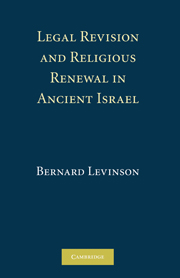Book contents
- Frontmatter
- Contents
- List of Figures
- Foreword, by Jean Louis Ska
- Preface
- Abbreviations
- 1 Biblical Studies as the Meeting Point of the Humanities
- 2 Rethinking the Relation between “Canon” and “Exegesis”
- 3 The Problem of Innovation within the Formative Canon
- 4 The Reworking of the Principle of Transgenerational Punishment: Four Case Studies
- 5 The Canon as Sponsor of Innovation
- 6 The Phenomenon of Rewriting within the Hebrew Bible: A Bibliographic Essay on Inner-Biblical Exegesis in the History of Scholarship
- Author Index
- Subject Index
- Index of Scriptural and Other Sources
2 - Rethinking the Relation between “Canon” and “Exegesis”
Published online by Cambridge University Press: 18 August 2009
- Frontmatter
- Contents
- List of Figures
- Foreword, by Jean Louis Ska
- Preface
- Abbreviations
- 1 Biblical Studies as the Meeting Point of the Humanities
- 2 Rethinking the Relation between “Canon” and “Exegesis”
- 3 The Problem of Innovation within the Formative Canon
- 4 The Reworking of the Principle of Transgenerational Punishment: Four Case Studies
- 5 The Canon as Sponsor of Innovation
- 6 The Phenomenon of Rewriting within the Hebrew Bible: A Bibliographic Essay on Inner-Biblical Exegesis in the History of Scholarship
- Author Index
- Subject Index
- Index of Scriptural and Other Sources
Summary
The idea of a scriptural canon is one of the most distinctive achievements of many major religions, both Western (Zoroastrianism, Judaism, Christianity, and Islām) and Eastern (the Pāli canon of Theravāda Buddhism). By locating its font of revelation or contemplative insight in foundational sources, however, a culture confronts an almost inevitable difficulty. The essence of a canon is that it be stable, self-sufficient, and delimited. As Moses twice admonished his addressees in Deuteronomy: “You must not add anything to what I command you nor take anything away from it, but shall keep the commandments of Yahweh your God” (Deut 4:2; similarly 13:1 [English, 12:32]). In the Bible, this so-called canon formula occurs primarily in the context of Israelite wisdom literature (Qoh 3:14; 12:12–13; cf. Sir 42:21; Rev 22:18–19). The association with any notion of canon, however, marks a postbiblical development. The formula actually has a long prehistory in the ancient Near East, where it originally sought to prevent royal inscriptions, including law collections and treaties (cf. 1 Macc 8:30), from being altered. In other contexts, it affirmed the adequacy of wisdom instruction. Only subsequently was it taken over by Deuteronomy's Israelite authors and applied to the Mosaic Torah. The formula makes it clear that its intent is to preclude both literary and doctrinal innovation by safeguarding the textual status quo.
With such fixity and textual sufficiency as its hallmarks, how can a canon be made to address the varying needs of later generations of religious communities?
- Type
- Chapter
- Information
- Legal Revision and Religious Renewal in Ancient Israel , pp. 12 - 21Publisher: Cambridge University PressPrint publication year: 2008



